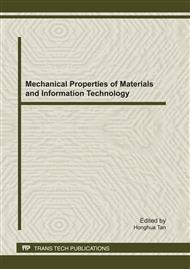p.64
p.70
p.76
p.81
p.88
p.95
p.99
p.104
p.109
Effect of Functionalized MWCNTs on the Tribological Properties of Polyimide Film
Abstract:
Multi-walled carbon nanotubes (MWCNTs) are incorporated into Polyimide (PI) film in both pristine and functionalized forms through in-situ polymerization. MWCNTs and NH2-MWCNTs lead to improved mechanical properties such as better tensile strength and elongation at break, as well as increased surface friction coefficient. The NH2-MWCNTs can reduce the total wear weight loss of the composite to a larger extent compared with MWCNTs. 1.0 wt% NH2-MWCNTs/PI has the lowest weight loss of 20.6 % of pure PI. Mechanism of two-stage wear procedure is discussed. We found that PI composite films with lower friction coefficient tend to lose less weight in the first stage, and the ones with better mechanical properties show better wear resistance in the whole wear procedure. Owing to the low surface energy, Natural mica is employed as the substrate for PI film.
Info:
Periodical:
Pages:
88-94
Citation:
Online since:
September 2011
Authors:
Price:
Сopyright:
© 2012 Trans Tech Publications Ltd. All Rights Reserved
Share:
Citation:


